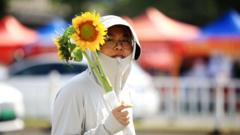Temperatures in eastern China have surged, prompting students to seek refuge in unconventional places as the heat overwhelms traditional housing options. With limited dormitory facilities, several students have opted to sleep in libraries or even outdoors in tents to escape the stifling heat. The recent surge in temperatures above 40°C has highlighted not only the discomfort of living without air-conditioning but also the rising costs for students seeking comfortable alternatives, like hotels, which have become hotspots for those not wishing to sweat through the night. A recent tragedy at Qingdao University, where a dormitory guard reportedly succumbed to heat stress, underscores the severity of the situation and has sparked a collective re-evaluation of how educational institutions prioritize the welfare of their staff and student population.
As extreme weather conditions persist across the nation, schools are beginning to respond. Universities are promptly exploring the possibility of air-conditioning installations, as some students express apprehension about dormitory living without adequate cooling. The rise in demand for electricity has also prompted discussions on sustainable solutions amid ongoing climate crises. With the growing recognition of climate changes and their tangible impacts, students and universities alike are grappling with ways to ensure comfort and safety during increasingly harsh summers in China.
As extreme weather conditions persist across the nation, schools are beginning to respond. Universities are promptly exploring the possibility of air-conditioning installations, as some students express apprehension about dormitory living without adequate cooling. The rise in demand for electricity has also prompted discussions on sustainable solutions amid ongoing climate crises. With the growing recognition of climate changes and their tangible impacts, students and universities alike are grappling with ways to ensure comfort and safety during increasingly harsh summers in China.




















